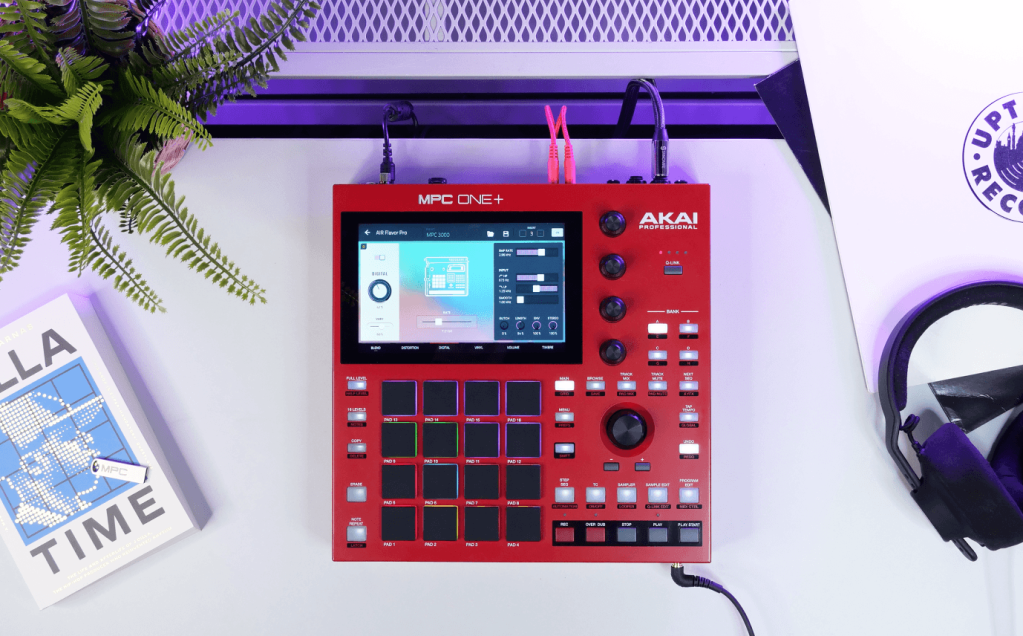The MPC One Plus now adds WiFi and Bluetooth and 16 GB of storage (up from 4 GB). And it runs the just-announced Juno-60-inspired plugin from AIR, too (also available as software plug-in). Plus that US$699 price is appealing.
Okay, there’s no way you would unveil a standalone groove machine in May 2023 and not be compared with the new Ableton Push. But I expect the real competition is Native Instruments’ Maschine+, which shares the workflow, 4×4 grid, and general approach of this device. There, the comparison is pretty favorable to Akai. NI hasn’t kept up with much in the way of updates since Maschine+’s unveiling. Akai has had a furious string of updates and undercuts NI on price.
The new Push is just a totally different beast, with a premium 8×8 MPE expressive grid, a far more refined look, and all the devices and DAW workflow out of Ableton Live, plus Max for Live. And, of course, there’s a far higher price that comes with those premium features.
But consider this. If you bought an MPC One+, and your friend had the new Push, and another friend had an iPad … and on and on … all of you can now connect via WiFi and jam with Ableton Link. That’s fantastic.

What’s new on the MPC One+ is basic but significant:
- WiFi/Bluetooth (which works with MIDI devices and Link – no Ethernet cable required).
- 16 GB storage.
- Uh, it’s red
But mainly, this is about that $699 price and wireless. And you still get all the software, instruments, effects, and features of the initial model, plus a touchscreen UI. There are also eight (!) mono CV/gate outputs you can use with analog gear. (Wait – red things from Akai with CV outs. Remember the AKAI MAX49? Back when nothing had CV outs, that fairly inexpensive and capable controller keyboard did. It was also called MAX before … certain streaming companies.) Memory is a bit anemic at 2GB, but at this price, who’s complaining?
The more mature software from Akai even bests Ableton’s new shiny on some fronts – with USB storage support, USB audio interface support, and an SD card slot. I do hope that storage and audio interface support is forthcoming from Ableton.
It’s not so much news, but a good reminder of how a) Akai made an entry level model with a bunch of features and b) keeps updating it.
Correction: An earlier draft of this story incorrectly suggested the CPU was updated. It’s the same as in the previous model – and the other One/Force models. We regret the error.
If you bought an MPC One+, and your friend had the new Push, and another friend had an iPad … and on and on … all of you can now connect via WiFi and jam with Ableton Link. That’s fantastic.
All in all, there’s no getting around it – this is a standalone device that’s more in the price range of a lot of musicians than the equivalent rigs from Ableton, NI, Elektron, and yeah, even the other Akai models. So I’m sure that’ll make some look closely at it.
If you buy something from a CDM link, we may earn a commission.
Available from Sweetwater:
If you buy something from a CDM link, we may earn a commission.
Nice video from loopop, too, with some wireless setup ideas.
Hat tip to people making these things; I don’t know how they dealt with this amount of hands-on new hardware at the same time. I’d run into the woods and take up the banjo. (Wait, that still sounds like a good idea!)
About that new AIR plug-in
Okay, I’ll be totally honest – my kneejerk reaction to the AIR “Jura” announcement was – please, I can’t deal with even one more JUNO plug-in.
But okay, the fact that you can run that plug-in on the $699 MPC One+ is impressive. (It’s not lost on me that the little Roland Boutique JU-06A with less polyphony is $399.)
And they’ve added some additional extras not on the original Juno hardware – which to me is a must for us even talking about this:
- Increased polyphony, unison, and chord modes atop the 6-voice mode as on the original
- VCF with saturation and drive
- Two DCO noise types (modern and vintage)
- Second envelope
- Delay, reverb, and EQ onboard
If you are interested in the software version, it’s on an intro price of US$74.99 with a 14-day demo. But to me, it’s probably the MPC/Force compatibility that’s a draw.
Otherwise, yeah, it is just another version of “a revered synth, first released in 1982.”
Look, now that you’ve read this far in this article for some reason and we’re caught again here in 1982, let’s watch some 1982 Radio Shack ads!
It’s not remotely Juno related, but hey, Merry Christmas.